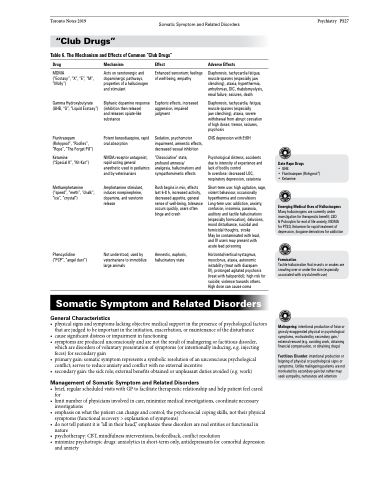Page 1191 - TNFlipTest
P. 1191
Toronto Notes 2019 Somatic Symptom and Related Disorders
Psychiatry PS27
“Club Drugs”
Table 6. The Mechanism and Effects of Common “Club Drugs”
Drug
MDMA
(“Ecstasy”, “X”, “E”, “M”, “Molly”)
Gamma Hydroxybutyrate (GHB, “G”, “Liquid Ecstasy”)
Flunitrazepam (Rohypnol®, “Roofies”, “Rope”, “The Forget Pill”)
Ketamine
(“Special K”, “Kit-Kat”)
Methamphetamine (“speed”, “meth”, “chalk”, “ice”, “crystal”)
Phencyclidine (“PCP”, “angel dust”)
Mechanism
Acts on serotonergic and dopaminergic pathways, properties of a hallucinogen and stimulant
Biphasic dopamine response (inhibition then release)
and releases opiate-like substance
Potent benzodiazepine, rapid oral absorption
NMDA receptor antagonist, rapid-acting general anesthetic used in pediatrics and by veterinarians
Amphetamine stimulant, induces norepinephrine, dopamine, and serotonin release
Not understood, used by veterinarians to immobilize large animals
Effect
Enhanced sensorium; feelings of well-being, empathy
Euphoric effects, increased aggression, impaired judgment
Sedation, psychomotor impairment, amnestic effects, decreased sexual inhibition
“Dissociative” state, profound amnesia/ analgesia, hallucinations and sympathomimetic effects
Rush begins in min, effects last 6-8 h, increased activity, decreased appetite, general sense of well-being, tolerance occurs quickly, users often binge and crash
Amnestic, euphoric, hallucinatory state
Adverse Effects
Diaphoresis, tachycardia fatigue, muscle spasms (especially jaw clenching), ataxia, hyperthermia, arrhythmias, DIC, rhabdomyolysis, renal failure, seizures, death
Diaphoresis, tachycardia, fatigue, muscle spasms (especially
jaw clenching), ataxia, severe withdrawal from abrupt cessation of high doses: tremor, seizures, psychosis
CNS depression with EtOH
Psychological distress, accidents due to intensity of experience and lack of bodily control
In overdose: decreased LOC, respiratory depression, catatonia
Short-term use: high agitation, rage, violent behaviour, occasionally hyperthermia and convulsions Long-term use: addiction, anxiety, confusion, insomnia, paranoia, auditory and tactile hallucinations (especially formication), delusions, mood disturbance, suicidal and homicidal thoughts, stroke
May be contaminated with lead, and IV users may present with acute lead poisoning
Horizontal/vertical nystagmus, myoclonus, ataxia, autonomic instability (treat with diazepam
IV), prolonged agitated psychosis (treat with haloperidol); high risk for suicide; violence towards others. High dose can cause coma
Date Rape Drugs
• GHB
• Flunitrazepam (Rohypnol®) • Ketamine
Emerging Medical Uses of Hallucinogens
Many hallucinogens are currently under investigation for therapeutic benefit; LSD
& Psilocybin for end of life anxiety, MDMA for PTSD, Ketamine for rapid treatment of depression, ibogaine derivatives for addiction
Formication
Tactile hallucination that insects or snakes are crawling over or under the skin (especially associated with crystal meth use)
Malingering: intentional production of false or grossly exaggerated physical or psychological symptoms, motivated by secondary gain / external reward (e.g. avoiding work, obtaining financial compensation, or obtaining drugs)
Factitious Disorder: intentional production or feigning of physical or psychological signs or symptoms. Unlike malingering patients are not motivated by secondary gain but rather may seek sympathy, nurturance and attention
Somatic Symptom and Related Disorders
General Characteristics
• physicalsignsandsymptomslackingobjectivemedicalsupportinthepresenceofpsychologicalfactors that are judged to be important in the initiation, exacerbation, or maintenance of the disturbance
• cause significant distress or impairment in functioning
• symptoms are produced unconsciously and are not the result of malingering or factitious disorder,
which are disorders of voluntary presentation of symptoms (or intentionally inducing, e.g. injecting
feces) for secondary gain
• primarygain:somaticsymptomrepresentsasymbolicresolutionofanunconsciouspsychological
conflict; serves to reduce anxiety and conflict with no external incentive
• secondary gain: the sick role; external benefits obtained or unpleasant duties avoided (e.g. work)
Management of Somatic Symptom and Related Disorders
• brief,regularscheduledvisitswithGPtofacilitatetherapeuticrelationshipandhelppatientfeelcared for
• limitnumberofphysiciansinvolvedincare,minimizemedicalinvestigations,coordinatenecessary investigations
• emphasisonwhatthepatientcanchangeandcontrol;thepsychosocialcopingskills,nottheirphysical symptoms (functional recovery > explanation of symptoms)
• donottellpatientitis“allintheirhead,”emphasizethesedisordersarerealentitiesorfunctionalin nature
• psychotherapy:CBT,mindfulnessinterventions,biofeedback,conflictresolution
• minimizepsychotropicdrugs:anxiolyticsinshort-termonly,antidepressantsforcomorbiddepression
and anxiety


